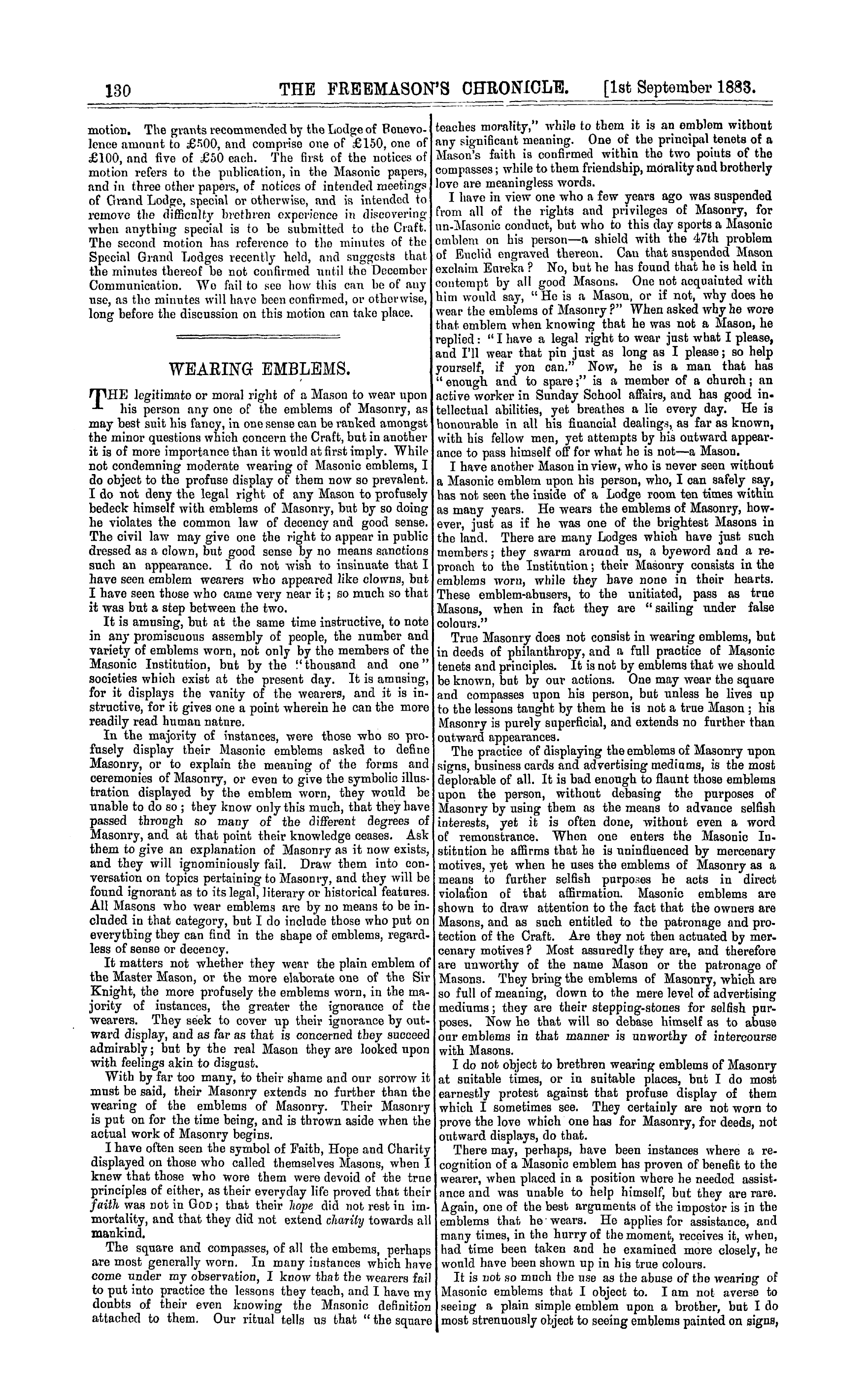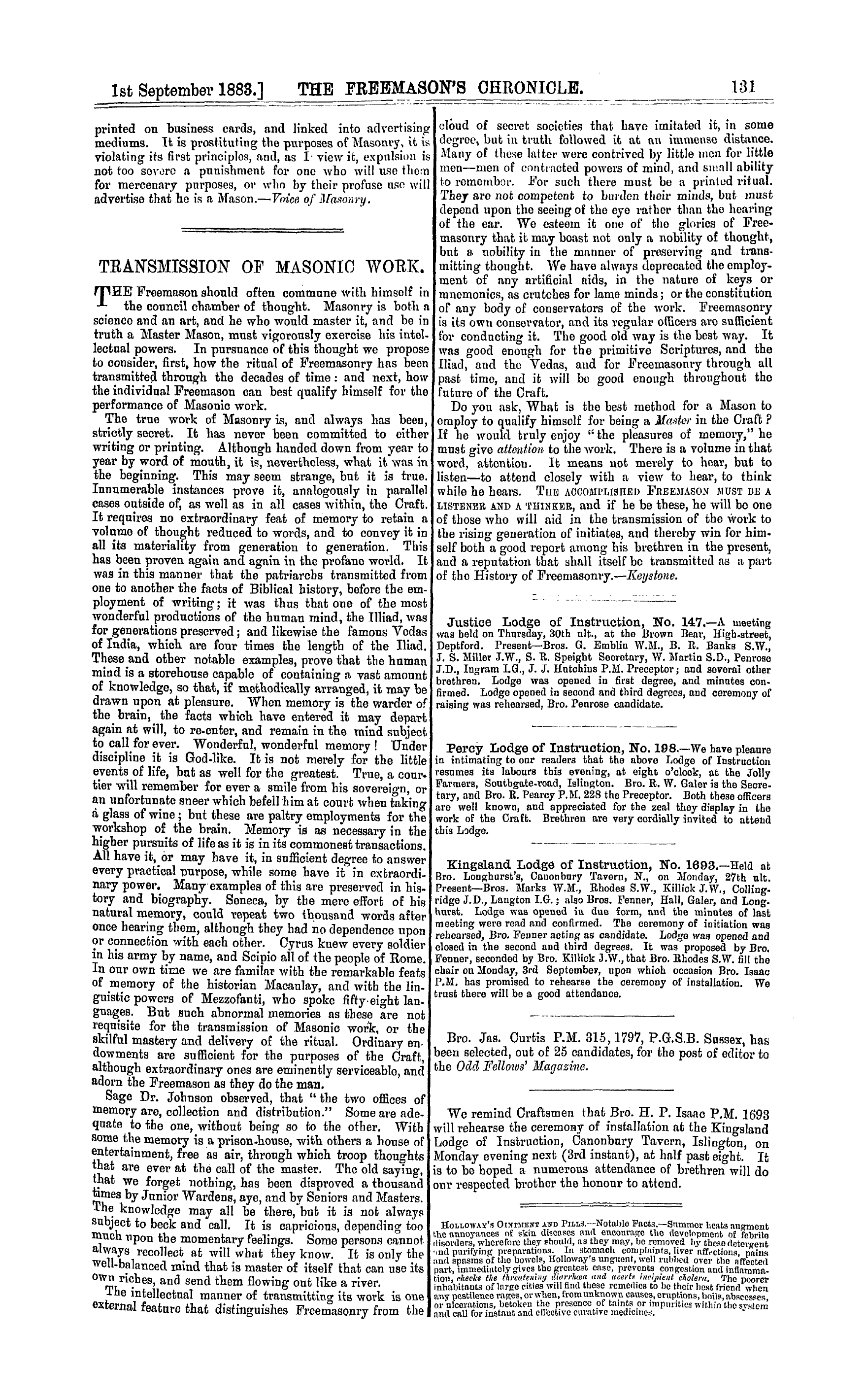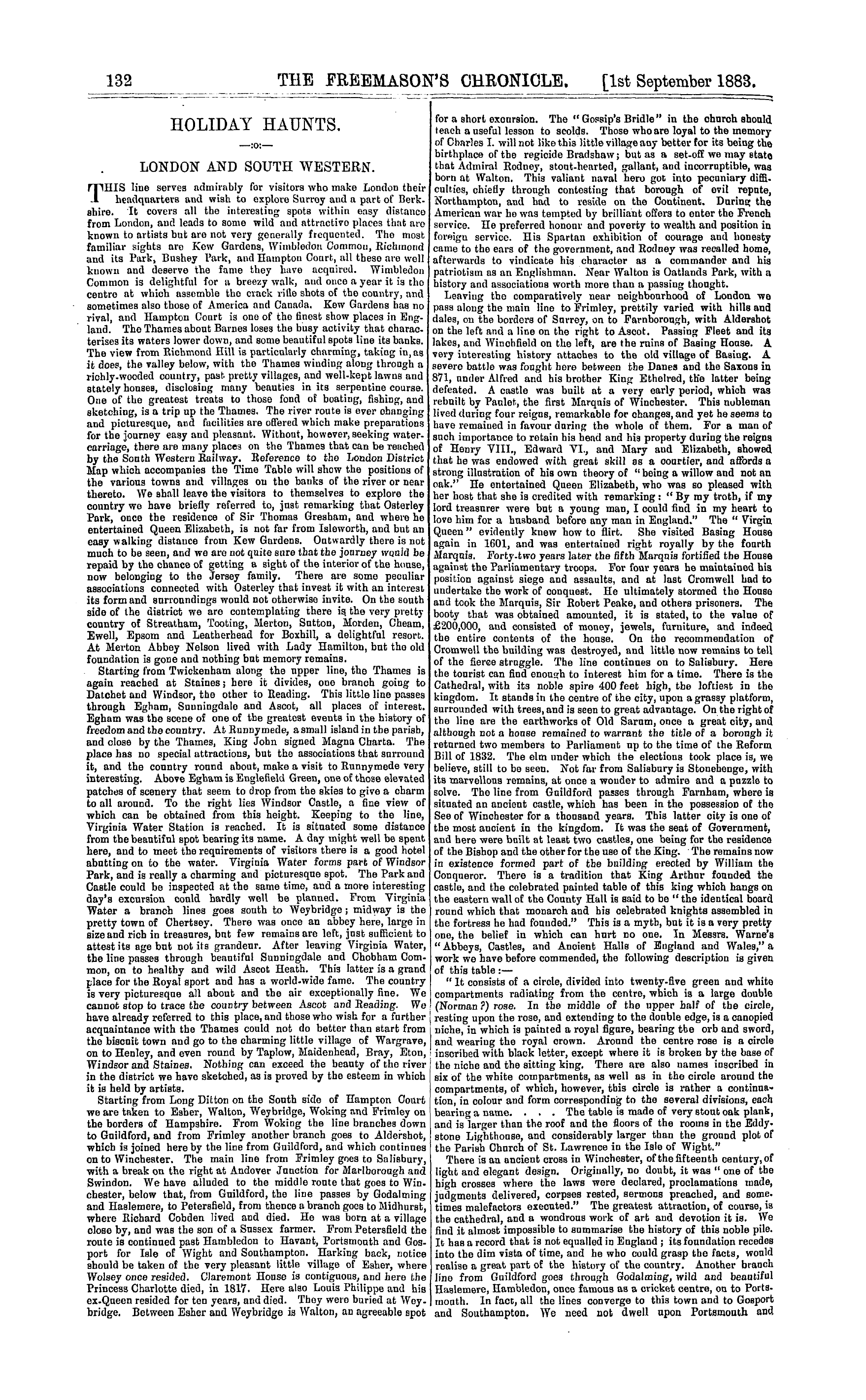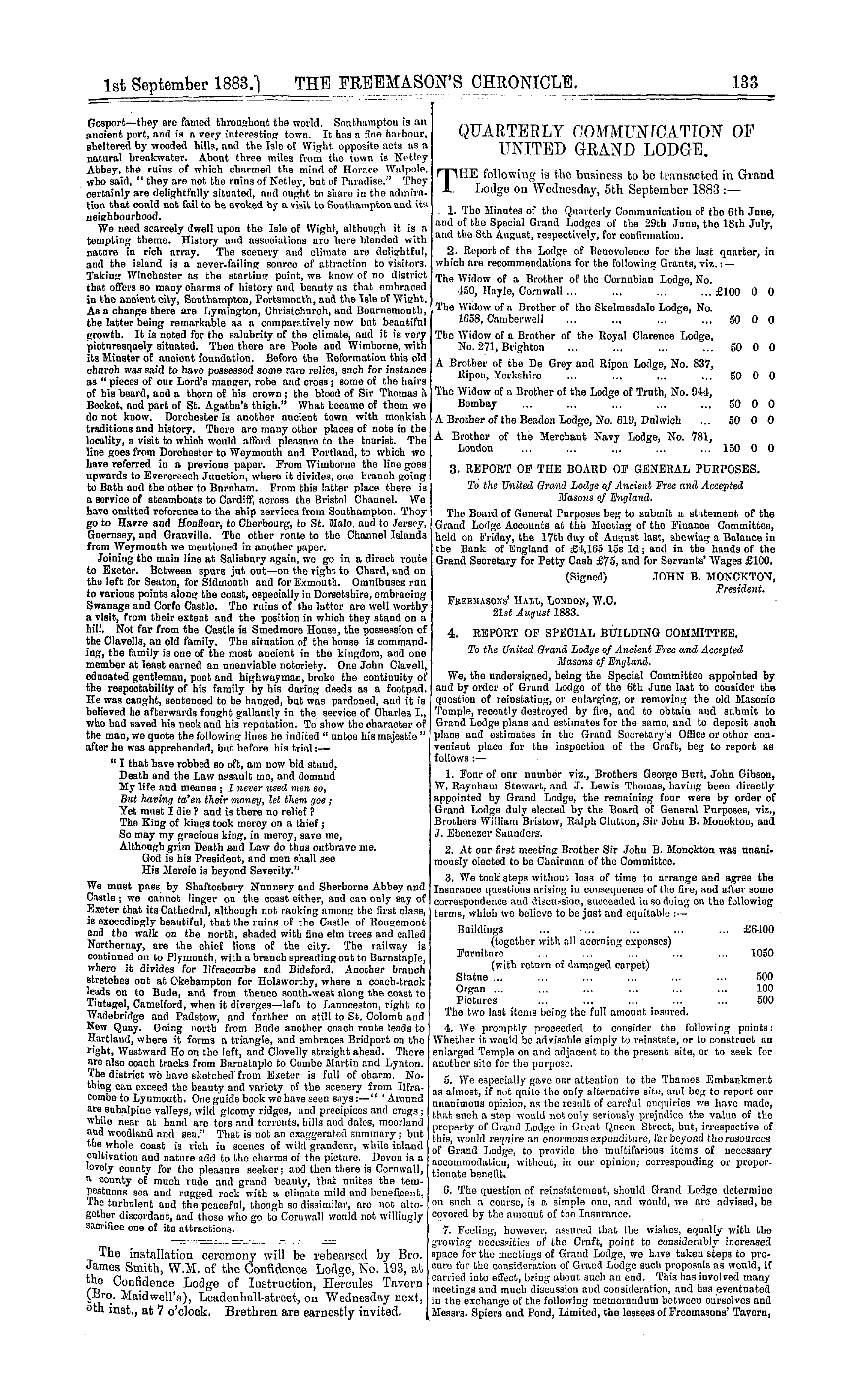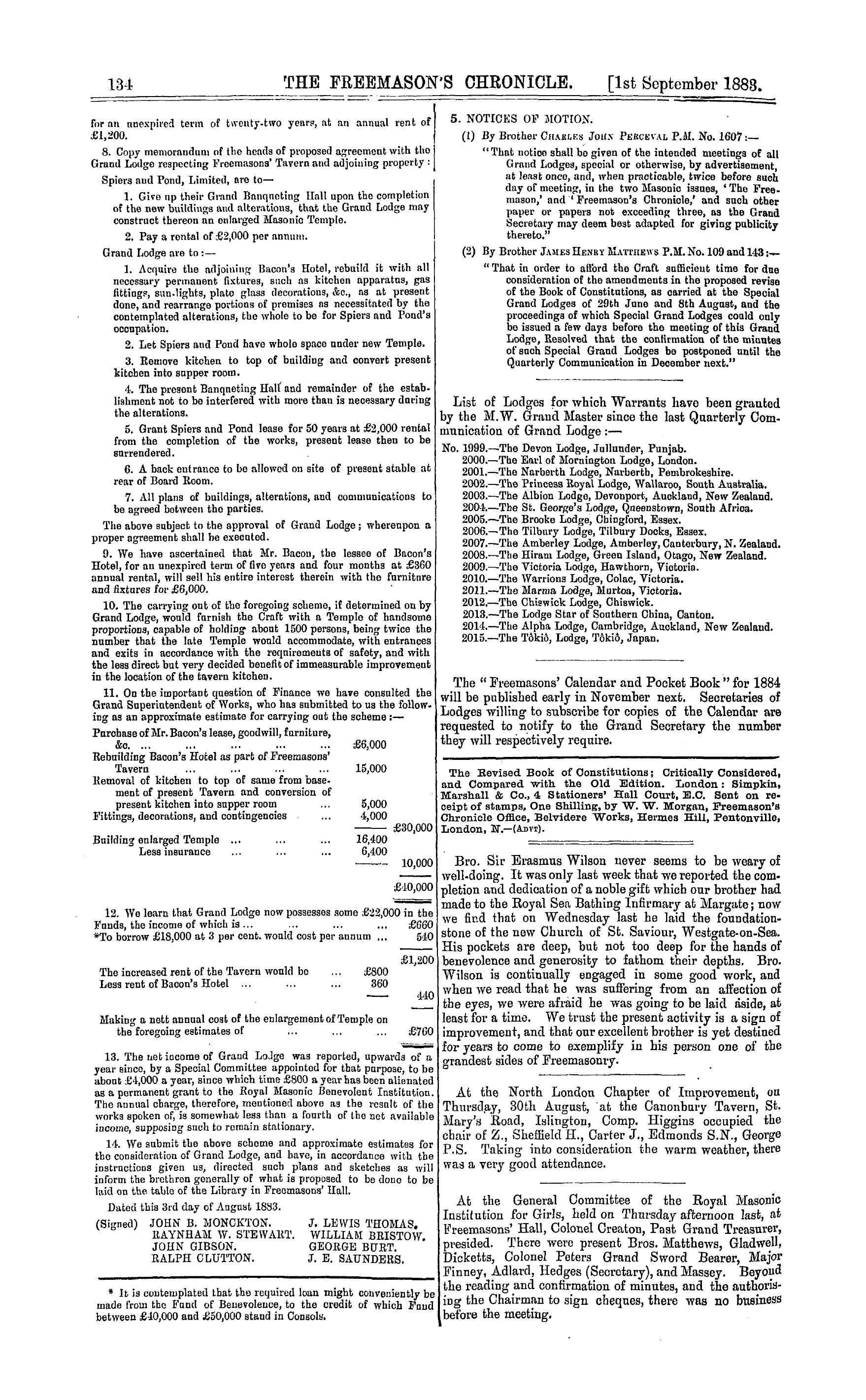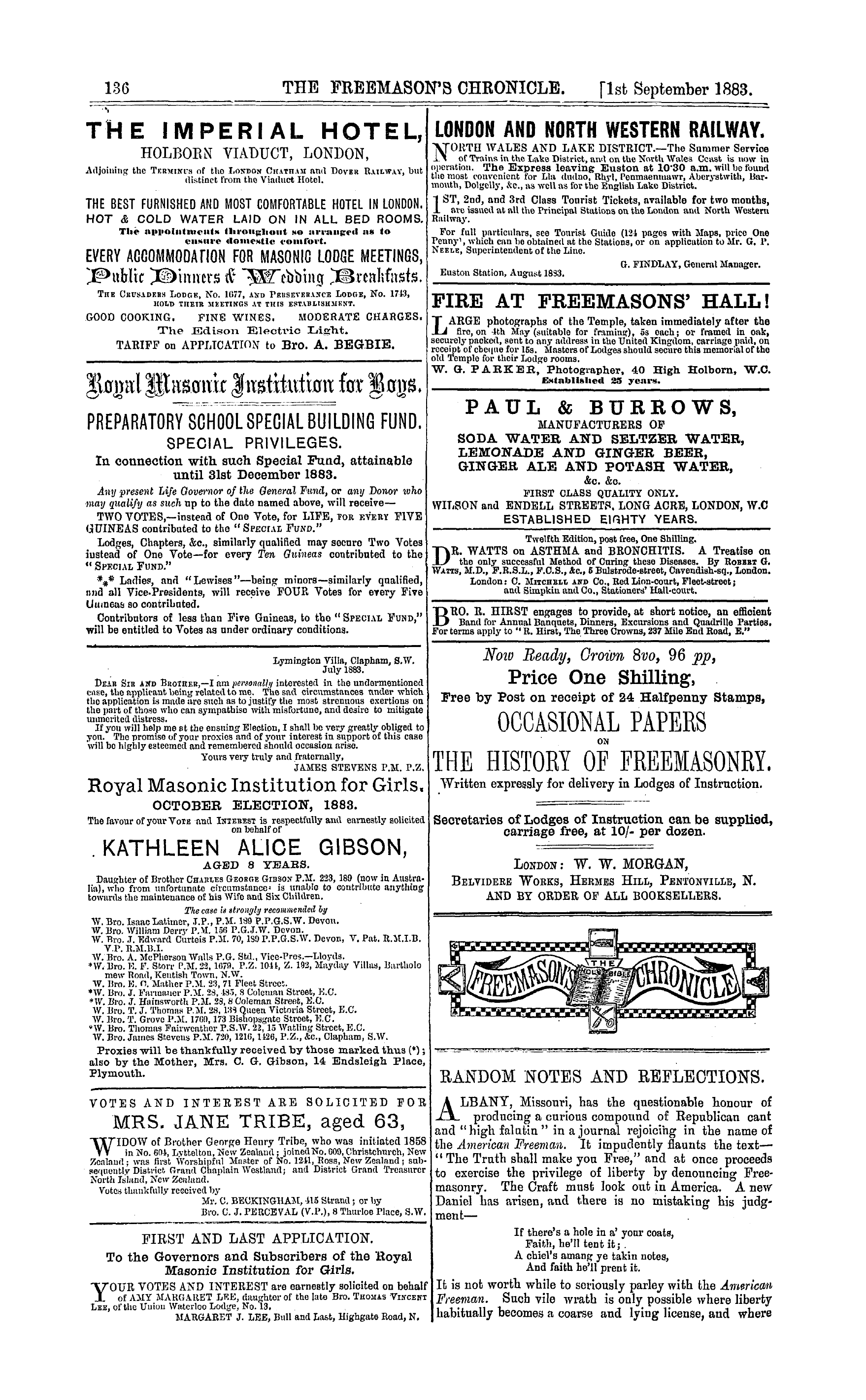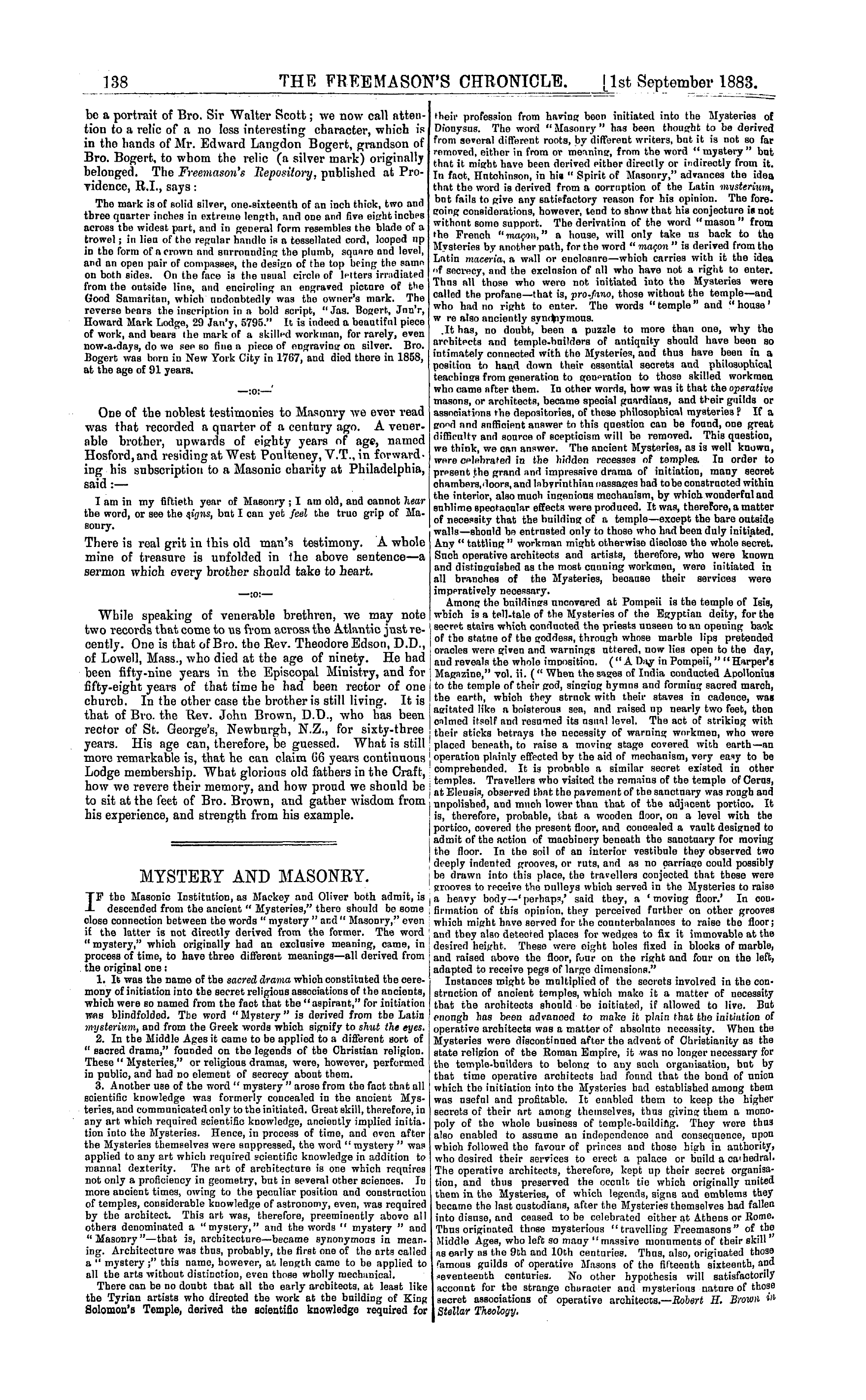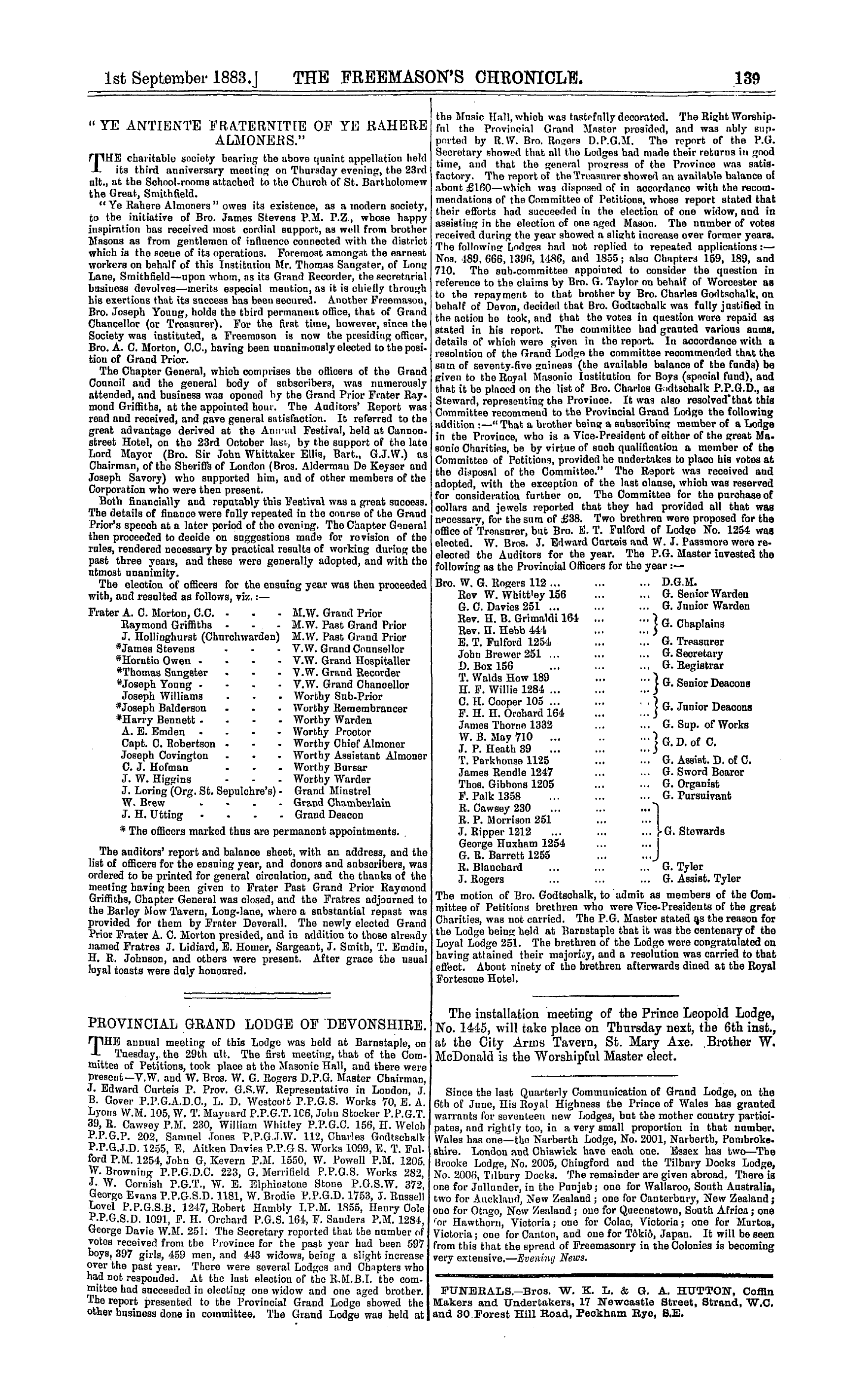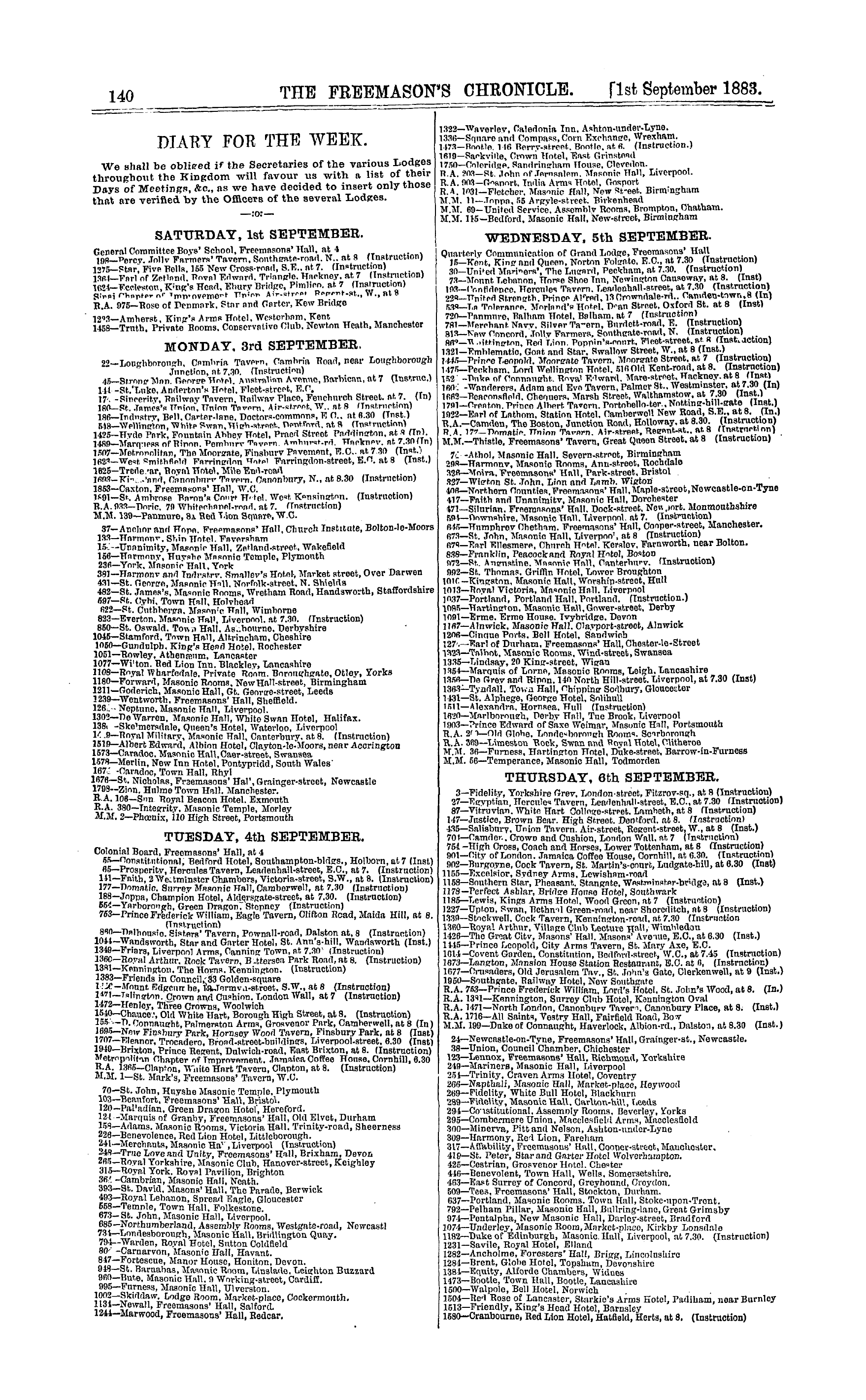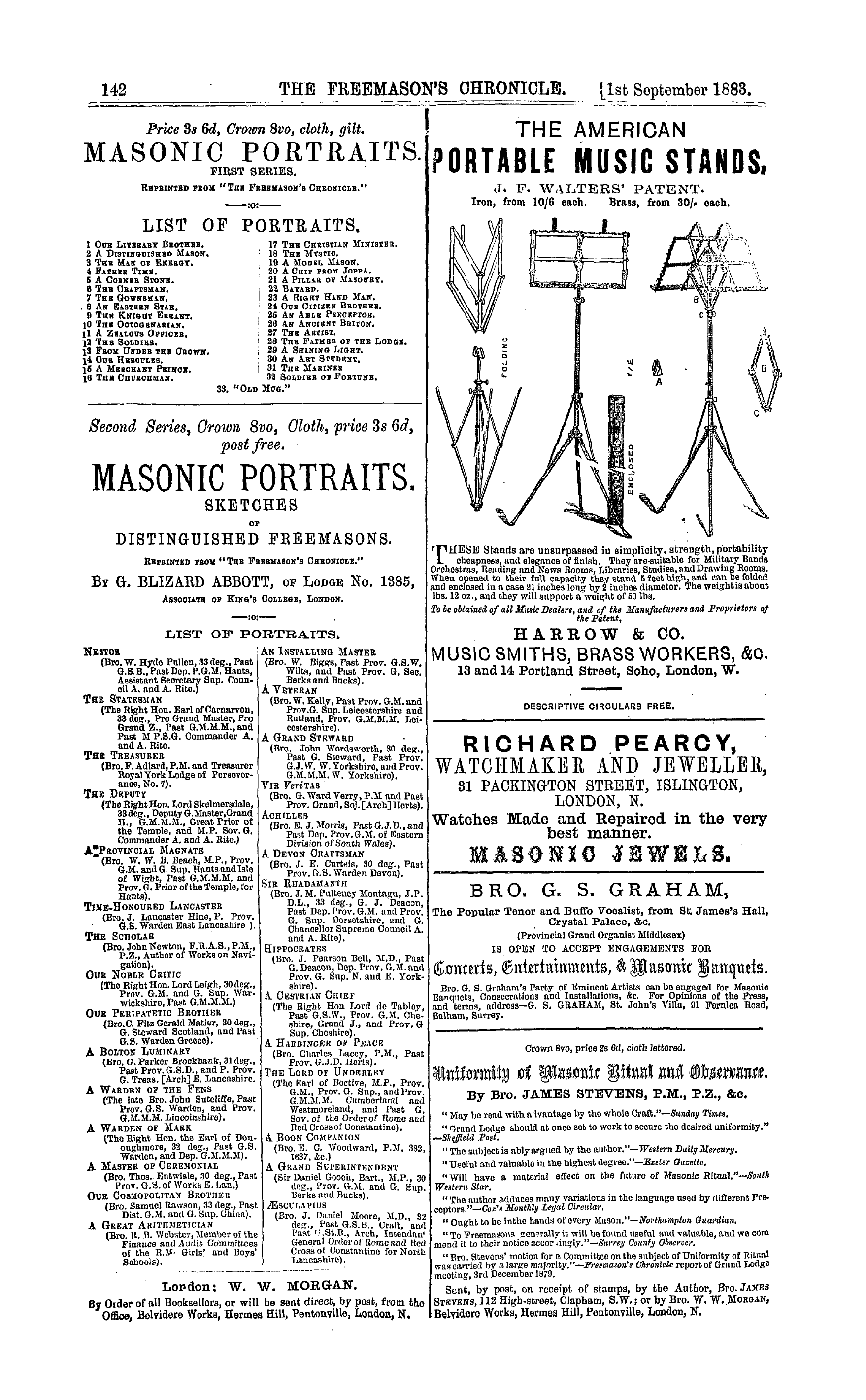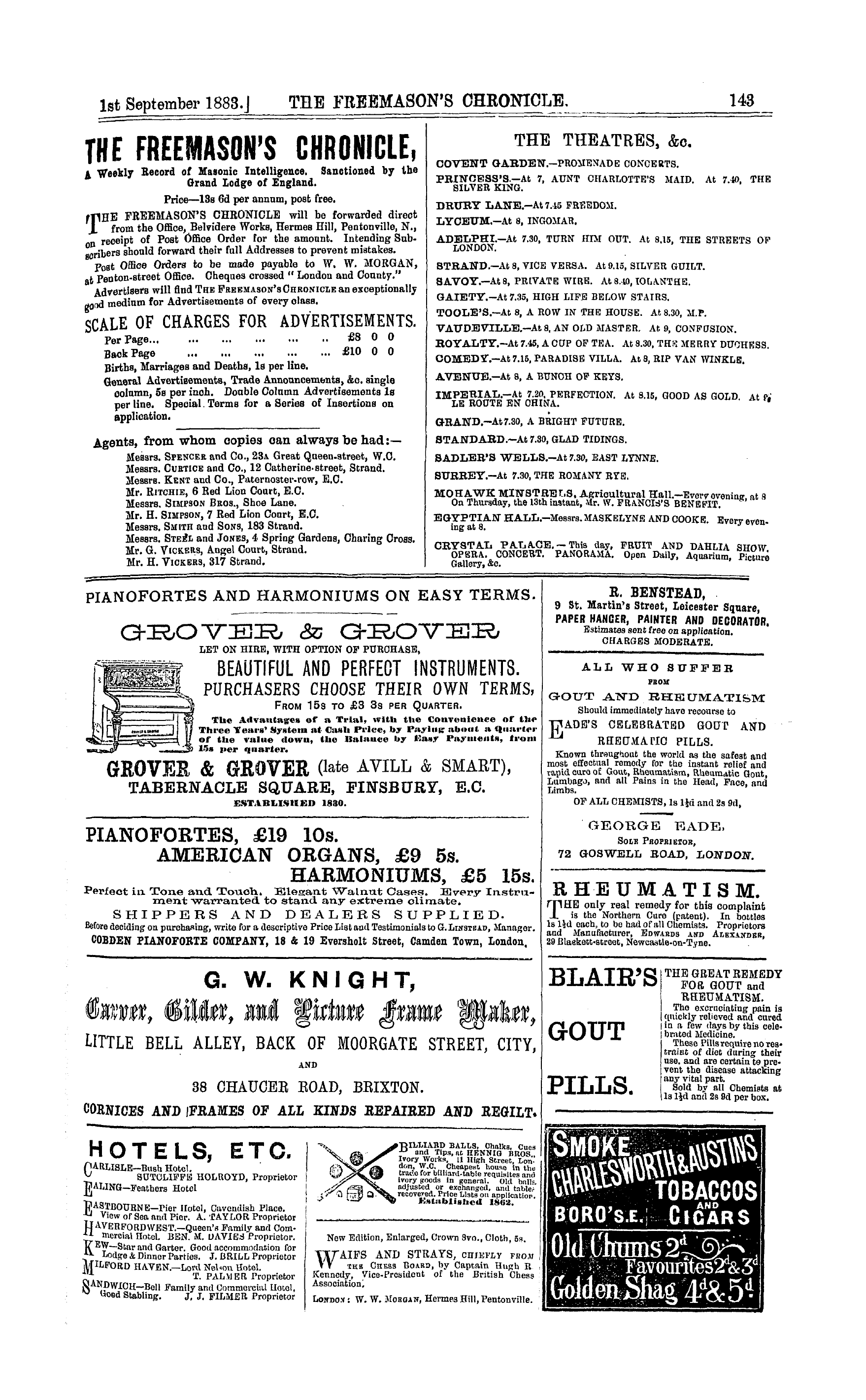-
Articles/Ads
Article RANDOM NOTES AND REFLECTIONS. ← Page 3 of 3 Article MYSTERY AND MASONRY. Page 1 of 1 Article MYSTERY AND MASONRY. Page 1 of 1
Note: This text has been automatically extracted via Optical Character Recognition (OCR) software.
Random Notes And Reflections.
be a portrait of Bro . Sir Walter Scott ; we now call attention to a relic of a no less interesting character , which is in the hands of Mr . Edward Langdon Bogert , grandson of Bro . Bogert , to whom the relic ( a silver mark ) originally belonged . The Freemason ' s Repository , published at Providence , R . I ., says :
The mark is of solid silver , one-sixteenth of an inch thick , two and three quarter inches in extreme length , and one and five eight inches across the widest part , and in general form resembles the blade of a trowel ; in lieu of the regular handle is a tessellated cord , looped np in the form of a crown and surrounding the plumb , square and level ,
and an open pair of compasses , the design of the top being the same on both sides . On the face is the usual circle of Inters irradiated from the ontside line , and encircling an engraved picture of the Good Samaritan , which undoubtedly was the owner ' s mark . The reverse bears the inscription in a bold script , " Jas . Bogert , Jnn ' r ,
Howard Mark Lodge , 29 Jan ' y , 5795 . " It is indeed a beautiful piece of work , and bears the mark of a skilled workman , for rarely , even now . a . days , do we see so fine a piece of engraving on silver . Bro . Bogert was born in New York City in 1767 , and died there in 1858 , at the age of 91 years .
One of the noblest testimonies to Masonry we ever read was that recorded a quarter of a century ago . A venerable brother , upwards of eighty years of age , named Hosford , and residing at West Poulteney , V . T ., in forwarding his subscription to a Masonic charity at Philadelphia , said : —
I am in my fiftieth year of Masonry ; I am old , and cannot hear the word , or see the s , igns , bnt I can yet feel the true grip of Masonry . There is real grit in this old man ' s testimony . A whole mine of treasure is unfolded in tbe above sentence—a sermon which every brother should take to heart .
While speaking of venerable brethren , we may note two records that come to us from across tbe Atlantic just recently . One is that of Bro . the Rev . Theodore Edson , D . D ., of Lowell , Mass ., who died at the age of ninety . He had been fifty-nine years in the Episcopal Ministry , and for
fifty-eight years of that time he had been rector of one church . In the other case the brother is still living . It is that of Bro . the Rev . John Brown , D . D ., who has been rector of St . George ' s , Newburgh , N . Z ., for sixty-three years . His age can , therefore , be guessed . What is still
more remarkable is , that he can claim 66 years continuous Lodge membership . What glorious old fathers in the Craft , how we revere their memory , and how proud we should be to sit at the feet of Bro . Brown , aud gather wisdom from his experience , and strength from his example .
Mystery And Masonry.
MYSTERY AND MASONRY .
IF the Masonic Institution , as Mackey and Oliver both admit , is descended from the ancient " Mysteries , " there should be some close connection between the words " mystery " and " Masonry , " even if the latter is not directly derived from the former . The word " mystery , " whioh originally had an exclusive meaning , came , in process of time , to have three different meanings—all derived from
the original one : 1 . I . was the name of the sacred drama which constituted the ceremony of initiation into the secret religious associations of the ancients , which were so named from the fact that the " aspirant , " for initiation WAS blindfolded . Tbe word "Mystery" is derived from tbe Latin mysterium , and from the Greek words which signify to shut the eyes .
2 . In the Middle Ages it came to be applied to a different sort of " sacred drama , " founded on the legends of the Christian religion . These " Mysteries , " or religious dramas , were , however , performed in pnblio , and had no element of secrecy about them . 3 . Another use of the word " mystery " arose from the fact that all scientific knowledge was formerly concealed in the ancient
Mysteries , and communicated only to the initiated . Great skill , therefore , in any art which required scientific knowledge , anciently implied initiation into the Mysteries . Hence , in process of time , and oven after the Mysteries themselves were suppressed , the word " mystery " was applied to any art which required scientific knowledge in addition to roannal dexterity . The art of architecture is one which requires
not only a proficiency in geometry , but in several other sciences . In more ancient times , owing to the peculiar position and construction of temples , considerable knowledge of astronomy , even , was required by the architect . This art was , therefore , preeminently above all others denominated a " mystery , " and the words " mystery " and " Masonry " —that is , architecture—became synonymous in mean .
ing . Architecture was thus , probably , tbe first one of the arts called a " mystery ; " this name , however , at length came to be applied to all the arts without distinction , even those wholly mechanical . There can be no doubt that all the early architects , at least like the Tyrian artists who directed the work at the building of King Solomon ' s Temple , derived the scientific knowledge required for
Mystery And Masonry.
their profession from having been initiated into the Mysteries of Dionysus . The word " Masonry " has been thought to be derived from several different roots , by different writers , but it is not so far removed , either in from or meaning , from the word " mystery " but that it might have been derived either directly or indirectly from it . In fact , Hutchinson , in hia " Spirit of Masonry , " advances the idea
that the word is derived from a corruption of the Latin mvsterium , bnt fails to give any satisfactory reason for his opinion . The foregoing considerations , however , lend to show that his conjecture is not withont some snpport . The derivation of the word " mason " from the French " macon , " a house , will only take us back to the Mysteries by another path , for the word " macon " is derived from the
Latin maceria , a wall or enclosure—whioh carries with it the idea » f seci-ecy , and the exclusion of all who have not a right to enter . Thns all those who were not initiated into the Mysteries were called the profane—that is , pro . fano , those without the temple—and who had no right to enter . The words " temple" and " house ' w re also anciently synf ^ iymous .
. It has , no doubt , been a puzzle to more than one , why the architects and temple-builders of antiquity should have been so intimately connected with the Mysteries , and thus have been in a position to hand down their essential secrets aud philosophical teachings from generation to generation to those skilled workmen who came after them . In other words , how was it that the operative
masons , or architects , became special guardians , and their guilds or associations the depositories , of these philosophical mysteries ? If a gond and sufficient answer to this question can be found , one great difficulty and source of scepticism will be removed . This question , we think , we can answer . The ancient Mysteries , as is well known , were celebrated in the hidden recesses of temples . In order to
present the grand and impressive drama of initiation , many secret ohambers . 'loors , and labyrinthian passages had to be constructed within the interior , also much ingenious mechanism , by which wonderful and sublime spectacular effects were produced . It was , therefore , a matter of necessity that the building of a temple—except the bare outside walls—should be entrusted only to those who had been duly initiated .
Any " tattling " workman might otherwise disclose the whole secret . Such operative architects and artists , therefore , who were known and distinguished as the most cunning workmen , were initiated in all branches of the Mysteries , because their services were imperatively necessary . Among the buildings uncovered at Pompeii is the temple of Isis ,
which is a tell-tale of the Mysteries of the Egyptian deity , for the secret stairs which conducted the priests unseen to an opening back of the statue of the goddess , through whose marble lips pretended oracles wero given and warnings uttered , now lies open to the day , and reveals the whole imposition . ( " A Day in Pompeii , " " Harpers Magazine , " vol . ii . ( " When the sages of India conducted Apolloniua
to the temple of their god , singing hymns and forming sacred march , the earth , whioh they struck with their staves in cadence , waa agitated like a boisterous sea , and raised up nearly two feet , then calmed itself and resumed its usual level . The act of striking with their sticks betrays the necessity of warning workmen , who were placed beneath , to raise a moving stage covered with earth—an
operation plainly effected by the aid of mechanism , very easy to be comprehended . It is probable a similar secret existed in other temples . Travellers who visited the remains of the temple of Cerus , at Eleusis , observed tbat the pavement of the sanctuary was rough and unpolished , and much lower than that of the adjacent portico . It is , therefore , probable , that a wooden floor , on a level with the
portico , covered the present floor , and concealed a vault designed to admit of the action of machinery beneath the sanctuary for moving the floor . In the soil of an interior vestibule they observed two deeply indented grooves , or ruts , and as no carriage could possibly be drawn into this place , the travellers conjected that these were grooves to receive the rmlleys which served in the Mysteries to raise
a heavy body—* perhaps , ' said they , a ' moving floor . In confirmation of this opinion , they perceived further on other grooves which might have served for the counterbalances to raise the floor j and they also detected places for wedges to fix it immovable at the desired height . These were eight holes fixed in blocks of marble , and raised above the floor , four on the right and four on the left ,
adapted to receive pegs of large dimensions . " Instances might be multiplied of the secrets involved in the construction of ancient temples , which make it a matter of necessity that the architects should be initiated , if allowed to live . But enough has been advanced to make ifc plain that the initiation of operative architects was a matter of absolute necessity . When the
Mysteries were discontinued after the advent of Christianity as the state religion of the Boman Empire , it was no longer necessary for the temple-builders to belong to any snch organisation , bnt by that time operative architects had found that the bond of union which the initiation into the Mysteries had established among them was useful and profitable . It enabled them to keep the higher
secrets of their art among themselves , thus giving them a monopoly of the whole business of temple-building . They were thus also enabled to assume an independence and consequence , upon which followed the favour of princes and those high in authority ) who desired their services to erect a palace or build a cathedral The operative architects , therefore , kent up their secret
organisation , and thus preserved the occult tie which originally united them in the Mysteries , of which legends , signs and emblems they became the last custodians , after the Mysteries themselves had fallen into disuse , and ceased to be celebrated either at Athens or Borne . Thus originated those mysterious "travelling Freemasons" of the Middle Ages , who left so many " massive monuments of their skill '
as early as the 9 th and 10 th centuries . Thus , also , originated those famous guilds of operative Masons of the fifteenth sixteenth , and seventeenth centuries . No other hypothesis will satisfactorily acconnt for the strange character and mysterious nature of those secret associations of operative architects . —Robert H . Brown in Stellar Theology .
Note: This text has been automatically extracted via Optical Character Recognition (OCR) software.
Random Notes And Reflections.
be a portrait of Bro . Sir Walter Scott ; we now call attention to a relic of a no less interesting character , which is in the hands of Mr . Edward Langdon Bogert , grandson of Bro . Bogert , to whom the relic ( a silver mark ) originally belonged . The Freemason ' s Repository , published at Providence , R . I ., says :
The mark is of solid silver , one-sixteenth of an inch thick , two and three quarter inches in extreme length , and one and five eight inches across the widest part , and in general form resembles the blade of a trowel ; in lieu of the regular handle is a tessellated cord , looped np in the form of a crown and surrounding the plumb , square and level ,
and an open pair of compasses , the design of the top being the same on both sides . On the face is the usual circle of Inters irradiated from the ontside line , and encircling an engraved picture of the Good Samaritan , which undoubtedly was the owner ' s mark . The reverse bears the inscription in a bold script , " Jas . Bogert , Jnn ' r ,
Howard Mark Lodge , 29 Jan ' y , 5795 . " It is indeed a beautiful piece of work , and bears the mark of a skilled workman , for rarely , even now . a . days , do we see so fine a piece of engraving on silver . Bro . Bogert was born in New York City in 1767 , and died there in 1858 , at the age of 91 years .
One of the noblest testimonies to Masonry we ever read was that recorded a quarter of a century ago . A venerable brother , upwards of eighty years of age , named Hosford , and residing at West Poulteney , V . T ., in forwarding his subscription to a Masonic charity at Philadelphia , said : —
I am in my fiftieth year of Masonry ; I am old , and cannot hear the word , or see the s , igns , bnt I can yet feel the true grip of Masonry . There is real grit in this old man ' s testimony . A whole mine of treasure is unfolded in tbe above sentence—a sermon which every brother should take to heart .
While speaking of venerable brethren , we may note two records that come to us from across tbe Atlantic just recently . One is that of Bro . the Rev . Theodore Edson , D . D ., of Lowell , Mass ., who died at the age of ninety . He had been fifty-nine years in the Episcopal Ministry , and for
fifty-eight years of that time he had been rector of one church . In the other case the brother is still living . It is that of Bro . the Rev . John Brown , D . D ., who has been rector of St . George ' s , Newburgh , N . Z ., for sixty-three years . His age can , therefore , be guessed . What is still
more remarkable is , that he can claim 66 years continuous Lodge membership . What glorious old fathers in the Craft , how we revere their memory , and how proud we should be to sit at the feet of Bro . Brown , aud gather wisdom from his experience , and strength from his example .
Mystery And Masonry.
MYSTERY AND MASONRY .
IF the Masonic Institution , as Mackey and Oliver both admit , is descended from the ancient " Mysteries , " there should be some close connection between the words " mystery " and " Masonry , " even if the latter is not directly derived from the former . The word " mystery , " whioh originally had an exclusive meaning , came , in process of time , to have three different meanings—all derived from
the original one : 1 . I . was the name of the sacred drama which constituted the ceremony of initiation into the secret religious associations of the ancients , which were so named from the fact that the " aspirant , " for initiation WAS blindfolded . Tbe word "Mystery" is derived from tbe Latin mysterium , and from the Greek words which signify to shut the eyes .
2 . In the Middle Ages it came to be applied to a different sort of " sacred drama , " founded on the legends of the Christian religion . These " Mysteries , " or religious dramas , were , however , performed in pnblio , and had no element of secrecy about them . 3 . Another use of the word " mystery " arose from the fact that all scientific knowledge was formerly concealed in the ancient
Mysteries , and communicated only to the initiated . Great skill , therefore , in any art which required scientific knowledge , anciently implied initiation into the Mysteries . Hence , in process of time , and oven after the Mysteries themselves were suppressed , the word " mystery " was applied to any art which required scientific knowledge in addition to roannal dexterity . The art of architecture is one which requires
not only a proficiency in geometry , but in several other sciences . In more ancient times , owing to the peculiar position and construction of temples , considerable knowledge of astronomy , even , was required by the architect . This art was , therefore , preeminently above all others denominated a " mystery , " and the words " mystery " and " Masonry " —that is , architecture—became synonymous in mean .
ing . Architecture was thus , probably , tbe first one of the arts called a " mystery ; " this name , however , at length came to be applied to all the arts without distinction , even those wholly mechanical . There can be no doubt that all the early architects , at least like the Tyrian artists who directed the work at the building of King Solomon ' s Temple , derived the scientific knowledge required for
Mystery And Masonry.
their profession from having been initiated into the Mysteries of Dionysus . The word " Masonry " has been thought to be derived from several different roots , by different writers , but it is not so far removed , either in from or meaning , from the word " mystery " but that it might have been derived either directly or indirectly from it . In fact , Hutchinson , in hia " Spirit of Masonry , " advances the idea
that the word is derived from a corruption of the Latin mvsterium , bnt fails to give any satisfactory reason for his opinion . The foregoing considerations , however , lend to show that his conjecture is not withont some snpport . The derivation of the word " mason " from the French " macon , " a house , will only take us back to the Mysteries by another path , for the word " macon " is derived from the
Latin maceria , a wall or enclosure—whioh carries with it the idea » f seci-ecy , and the exclusion of all who have not a right to enter . Thns all those who were not initiated into the Mysteries were called the profane—that is , pro . fano , those without the temple—and who had no right to enter . The words " temple" and " house ' w re also anciently synf ^ iymous .
. It has , no doubt , been a puzzle to more than one , why the architects and temple-builders of antiquity should have been so intimately connected with the Mysteries , and thus have been in a position to hand down their essential secrets aud philosophical teachings from generation to generation to those skilled workmen who came after them . In other words , how was it that the operative
masons , or architects , became special guardians , and their guilds or associations the depositories , of these philosophical mysteries ? If a gond and sufficient answer to this question can be found , one great difficulty and source of scepticism will be removed . This question , we think , we can answer . The ancient Mysteries , as is well known , were celebrated in the hidden recesses of temples . In order to
present the grand and impressive drama of initiation , many secret ohambers . 'loors , and labyrinthian passages had to be constructed within the interior , also much ingenious mechanism , by which wonderful and sublime spectacular effects were produced . It was , therefore , a matter of necessity that the building of a temple—except the bare outside walls—should be entrusted only to those who had been duly initiated .
Any " tattling " workman might otherwise disclose the whole secret . Such operative architects and artists , therefore , who were known and distinguished as the most cunning workmen , were initiated in all branches of the Mysteries , because their services were imperatively necessary . Among the buildings uncovered at Pompeii is the temple of Isis ,
which is a tell-tale of the Mysteries of the Egyptian deity , for the secret stairs which conducted the priests unseen to an opening back of the statue of the goddess , through whose marble lips pretended oracles wero given and warnings uttered , now lies open to the day , and reveals the whole imposition . ( " A Day in Pompeii , " " Harpers Magazine , " vol . ii . ( " When the sages of India conducted Apolloniua
to the temple of their god , singing hymns and forming sacred march , the earth , whioh they struck with their staves in cadence , waa agitated like a boisterous sea , and raised up nearly two feet , then calmed itself and resumed its usual level . The act of striking with their sticks betrays the necessity of warning workmen , who were placed beneath , to raise a moving stage covered with earth—an
operation plainly effected by the aid of mechanism , very easy to be comprehended . It is probable a similar secret existed in other temples . Travellers who visited the remains of the temple of Cerus , at Eleusis , observed tbat the pavement of the sanctuary was rough and unpolished , and much lower than that of the adjacent portico . It is , therefore , probable , that a wooden floor , on a level with the
portico , covered the present floor , and concealed a vault designed to admit of the action of machinery beneath the sanctuary for moving the floor . In the soil of an interior vestibule they observed two deeply indented grooves , or ruts , and as no carriage could possibly be drawn into this place , the travellers conjected that these were grooves to receive the rmlleys which served in the Mysteries to raise
a heavy body—* perhaps , ' said they , a ' moving floor . In confirmation of this opinion , they perceived further on other grooves which might have served for the counterbalances to raise the floor j and they also detected places for wedges to fix it immovable at the desired height . These were eight holes fixed in blocks of marble , and raised above the floor , four on the right and four on the left ,
adapted to receive pegs of large dimensions . " Instances might be multiplied of the secrets involved in the construction of ancient temples , which make it a matter of necessity that the architects should be initiated , if allowed to live . But enough has been advanced to make ifc plain that the initiation of operative architects was a matter of absolute necessity . When the
Mysteries were discontinued after the advent of Christianity as the state religion of the Boman Empire , it was no longer necessary for the temple-builders to belong to any snch organisation , bnt by that time operative architects had found that the bond of union which the initiation into the Mysteries had established among them was useful and profitable . It enabled them to keep the higher
secrets of their art among themselves , thus giving them a monopoly of the whole business of temple-building . They were thus also enabled to assume an independence and consequence , upon which followed the favour of princes and those high in authority ) who desired their services to erect a palace or build a cathedral The operative architects , therefore , kent up their secret
organisation , and thus preserved the occult tie which originally united them in the Mysteries , of which legends , signs and emblems they became the last custodians , after the Mysteries themselves had fallen into disuse , and ceased to be celebrated either at Athens or Borne . Thus originated those mysterious "travelling Freemasons" of the Middle Ages , who left so many " massive monuments of their skill '
as early as the 9 th and 10 th centuries . Thus , also , originated those famous guilds of operative Masons of the fifteenth sixteenth , and seventeenth centuries . No other hypothesis will satisfactorily acconnt for the strange character and mysterious nature of those secret associations of operative architects . —Robert H . Brown in Stellar Theology .

